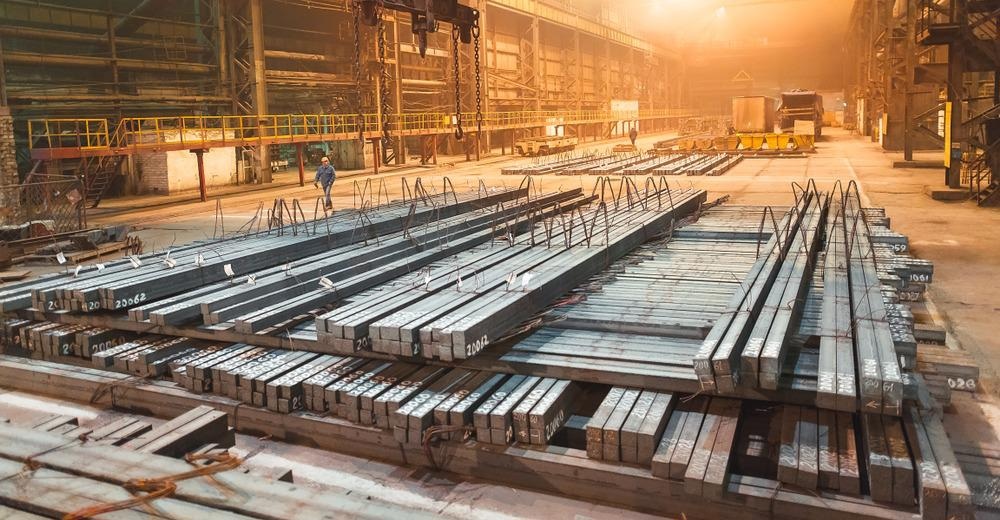
Image Credit: David Tadevosian/Shutterstock.com
The production of ubiquitous metal steel contributes to around 8% of the total carbon dioxide (CO2) emissions released into the environment each year. As 75% of the energy used to produce steel comes from coal, efforts by companies such as H2 Green Steel to decarbonize the steel production process are expected to transform the carbon footprint of this industry.
Uses of Steel in Industrial Applications
The high tensile strength and low cost of steel have led this material to become an essential component of modern society. Steel can be found in buildings, infrastructure, tools, ships, trains, cars, machines, electrical appliances, and weapons.
In addition to these traditional applications of steel, this material will be fundamental to the development of sustainable products in the future. For example, steel is likely to be incorporated into energy-efficient vehicles, new efficient power stations, the development of smart electrical grids, as well as the construction of high energy-efficient commercial buildings and residential housing units.
Steel is currently used to manufacture the motor, car body, and battery in electric vehicles (EVs). Steel is an ideal material for EV components due to its tensile strength. It protects passengers inside the vehicle in the event of a crash, and also the battery and its contents during a crash and on a day-to-day basis by preventing any unwanted leaks or dissipation of battery contents that could occur during particularly hot days.
The Carbon Footprint of Steel Production
It is estimated that more than 1.3 billion tons of steel are manufactured and used each year. For every ton of steel produced, it is estimated that 1.9 tons of carbon dioxide (CO2) will be released into the atmosphere, equating to around 8% of global CO2 emissions.
In Europe alone, steel production is responsible for more than 25% of this continent’s annual industrial CO2 emissions. For comparison, the CO2 emissions of the European steel industry are greater than the emission produced from all flight departments in the European Union (EU).
In China, which is responsible for over 51% of global steel production, the CO2 emissions released by this nation’s steel industry in 2020 are estimated at 1573 million tons (Mt).
As China as well as other nations throughout Latin America, Asia, and Africa plan to increase their production of steel, there has never been a more important time to decarbonize this industry.
Efforts to Decarbonize Steel Production
The Stockholm-based company H2 Green Steel has committed itself to eliminate virtually all CO2 emissions from the steel production process. As compared to traditional steel production processes that utilize blast or electric arc furnaces to combine iron ore and limestone with coke, which is a form of coal that has been previously heated to remove impurities, H2 steel instead plans to eliminate coke with hydrogen.
With a budget of approximately $3 billion US dollars (USD), or €2.5 billion, H2 Green Steel will use hydrogen energy that was previously produced from Sweden’s Boden-Luleå region, to power its arc furnaces. This novel production process, which is expected to begin by 2024, will eliminate any CO2 emissions that were normally produced when coke was used. Furthermore, the only thing that will be released from this steel production process will be water, creating an emission-free steel production pipeline.
By the year 2030, H2 Green Steel anticipates that over five million tons of high-quality zero-emission steel will be produced each year. This announcement by H2 Green Steel is significant, as its successful implementation of this project will create the world’s first large-scale fossil-free steel plant. Furthermore, through its production of hot rolled, cold rolled, and galvanized steel coils, H2 Green Steel anticipates that its clean steel products will be sold to various automotive, transportation, construction, furniture, pipeline, industrial equipment, and white goods markets worldwide.
The Future of Clean Steel in EVs
As compared to conventional vehicles, which contain an internal combustion engine that releases tailpipe emissions that contribute to smog, haze, and health problems, hybrid electric vehicles (HEVs), as well as both plug-in hybrid electric vehicles (PHEVs) and all-EVs, produce much less or no tailpipe emissions.
Although HEVs, PHEVs, and EVs are associated with reduced production of direct emissions, each of these vehicles runs on electricity that may not have necessarily been produced through clean electricity sources. It is estimated that natural gas accounts for 40% of all electricity produced in the United States, followed by nuclear energy and coal that are used to produce 19.76% and 19.36%, respectively, of the electricity in this nation.
In addition to the transition from these conventional electricity sources to renewable energy for electricity generation, the concept of a totally clean electric vehicle must also consider how the materials for these vehicles are produced. The H2 Green Steel initiative will therefore move the EV industry one step closer towards truly achieving zero emissions by incorporating high-quality fossil-free steel into the production of these vehicles.
References and Further Reading
Steel’s Contribution to a Low Carbon Future [Online]. Available from: https://worldsteel.org/
Accelerating the decarbonization of steel production [Online]. Available from: https://www.h2greensteel.com/
Analysis: Surge in China’s steel production helps to fuel record-high CO2 emissions [Online]. Available from: https://www.carbonbrief.org/analysis-surge-in-chinas-steel-production-helps-to-fuel-record-high-co2-emissions
How Clean is the U.S. Steel Industry? [Online]. Available from: https://www.globalefficiencyintel.com/us-steel-industry-benchmarking-energy-co2-intensities
World’s largest hydrogen “green steel” plant to open in Sweden by 2024 [Online]. Available from: https://newatlas.com/energy/h2gs-green-hydrogen-steel/
The role of steel in electromobility [Online]. Available from: https://www.voestalpine.com/blog/en/mobility/automotive-en/the-role-of-steel-in-electromobility/
Emissions from Hybrid and Plug-In Electric Vehicles [Online]. Available from: https://afdc.energy.gov/vehicles/electric_emissions.html
Disclaimer: The views expressed here are those of the author expressed in their private capacity and do not necessarily represent the views of AZoM.com Limited T/A AZoNetwork the owner and operator of this website. This disclaimer forms part of the Terms and conditions of use of this website.